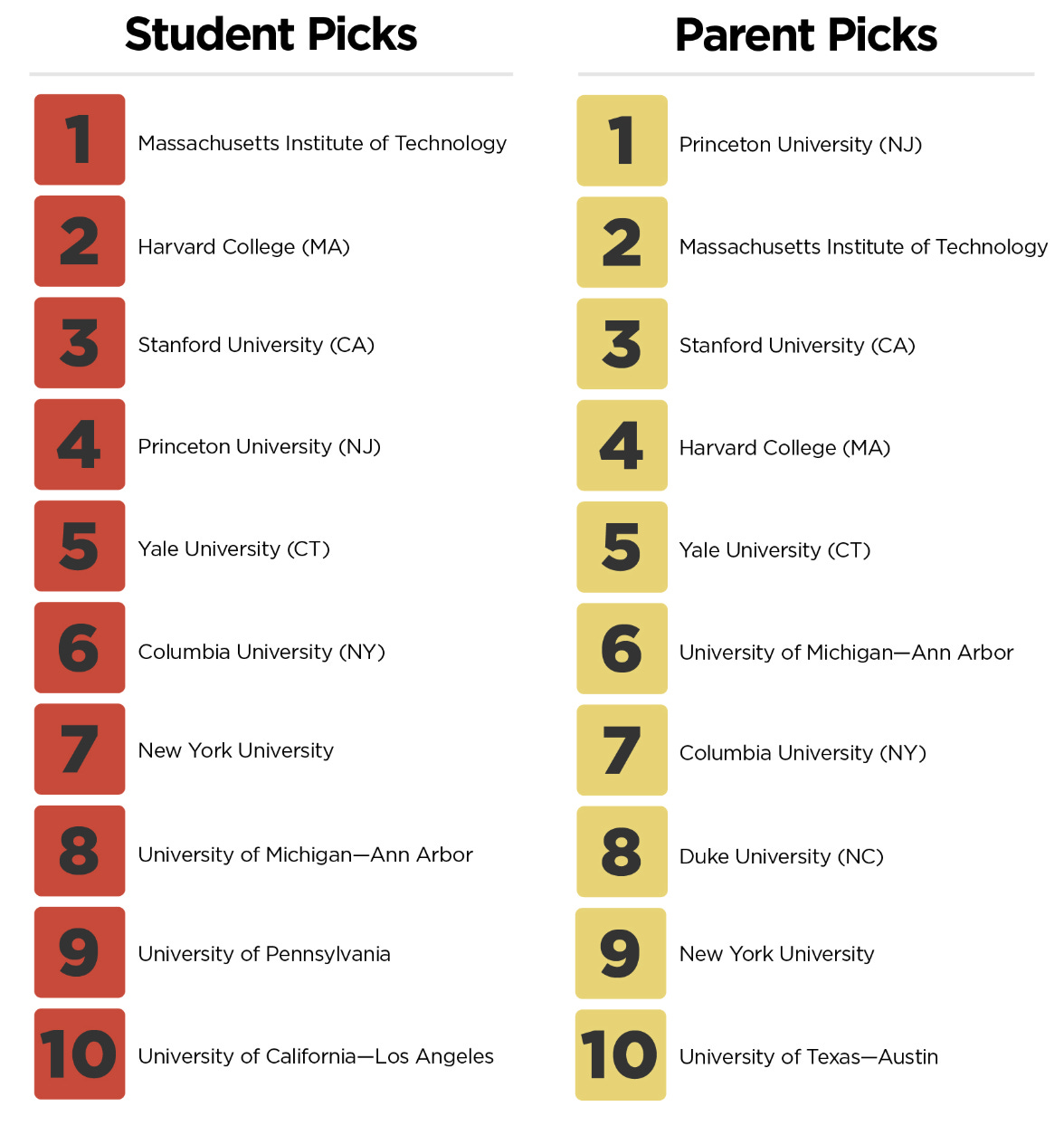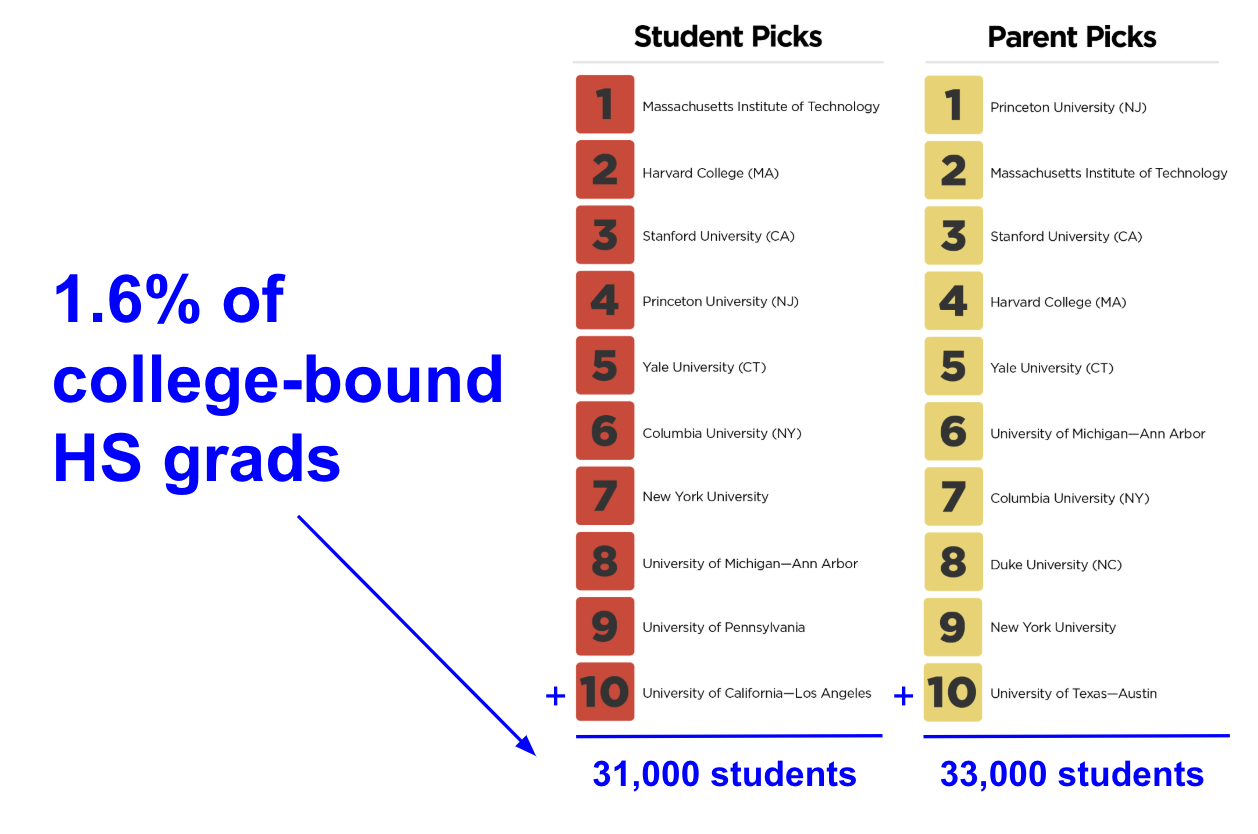Princeton Review’s “Dream Schools” vs Reality
The Princeton Review’s 2025 College Hopes & Worries Survey reveals the most sought-after ‘Dream Schools,’ highlighting the power of branding, prestige, and social influence.
The Myth of “Dream Schools”: Why College Branding is Driving Admissions Anxiety
This past week, the Princeton Review released its annual (2025) Colleges Hopes and Worries Survey Report. The survey, based on responses from nearly 9,000 students and parents, offers a snapshot of which schools capture the most attention—and how families feel about the challenges of the admissions process.
The list of “Dream Schools” is probably a strong indicator of college branding, marketing, and mindshare among students and parents today. And certainly reflects the college names I regularly hear.
It’s also a little bit sad.
Unless, of course, you work in the marketing department at these schools. Then you should be very, very happy.
Elite Colleges Rule the Dream List
Students and parents continue to gravitate toward the same “brand-name” colleges—Harvard, Stanford, MIT—which highlights just how effective these institutions have been at reinforcing their prestige and desirability over time. Decades of strategic marketing, selectivity, and reputation-building have cemented these schools at the top of the aspirational hierarchy.
Brand Awareness and Urban Appeal
Schools like NYU, Michigan, UCLA, and UT Austin breaking into the Dream School rankings (ahead of Ivy League institutions like Dartmouth and Brown or elite STEM powerhouses like Caltech) signal a shift: strong branding and the appeal of major metropolitan areas are now competing with traditional Ivy League prestige. Ten years ago, UCLA received about 100,000 1st year applications. This past year, they received about 150,000. The combination of urban energy, cultural relevance, and name recognition is drawing students and families in—especially as Ivy League acceptance rates can be as low as 4%.
Marketing Hype vs. Fit
A question I have: Are students choosing these schools because they’re truly the best fit for them academically, socially, and personally—or because they’ve been marketed as the pinnacle of success? The results suggest that branding, rather than careful self-assessment, plays an outsized role in shaping what students believe they want.
Status and Social Influence Matter (Maybe Too Much)
Let’s be honest—many of the “Dream Schools” function as social currency. They’re a shorthand for success, a way to signal ambition and achievement. But choosing a college based on status rather than substance isn’t always best. The right college fit isn’t about impressing others; it’s about finding the best environment for learning, growth, and opportunity.
The 1%
I’ve taken the liberty of fixing the Princeton Review’s chart.
About 2,000,000 high school seniors will enroll in college this fall.
The total number of students who will enroll as first-years at the 10 schools on Princeton Review’s Dream Schools list? Just over 30,000.
That means only 1.6% of 1st year students will actually attend one of these so-called dream schools.
Yet, these schools dominate the conversation—shaping aspirations, fueling competition, and making admissions feel like a high-stakes lottery.
Two Big Problems
1. Overlooking Fit
There are 2,400 four-year colleges in the U.S., yet students and families continue to focus on an ultra-narrow slice of them. The result? Thousands of students missing out on great programs, better financial aid (UT Austin, for instance, doesn’t meet 100% of demonstrated need), and schools that might actually be a better fit for their academic and career goals.
2. Admissions Tail Wagging the Dog
A small number of elite colleges dictate broader admissions behaviors, even for students who won’t apply to them.
An example? Standardized testing.
Schools on this year’s Dream List—Harvard, MIT, Stanford (starting 2026), Yale, and UT Austin—have all reinstated test score requirements.
But only 4% of colleges require test scores today, compared to 55% pre-pandemic.
Millions of students still take the SAT/ACT—partly because these top-tier institutions shape the norms that trickle down to the rest of the admissions process.
“Dream Schools” - An Ultra-Luxury Good
The Freakanomics podcast once explored a fascinating idea in an episode titled “The University of Impossible-to -Get-Into”.
Typically, when demand for a product skyrockets, supply increases. But not in elite college admissions.
As one guest on the podcast put it:
“The one market where you see this not happening as much is in the market for luxury goods. Take, for example, Hermes.”
Schools like Harvard and Stanford could significantly expand their freshman class sizes, but they don’t. Instead, they keep supply artificially low—much like luxury brands do.
And the numbers back this up:
The total number of first-year students enrolling across all Ivy League schools? Just 16,800.
That’s 0.8% of all U.S. college enrollees—about the same market share as Bentley, Lamborghini, Rolls-Royce, McLaren, Maserati, and Porsche collectively have in new U.S. car sales.
Yet, in the car world, enthusiasts have a much broader set of dream cars—everything from a Toyota Land Cruiser to a Ford Mustang or a Jeep Wrangler.
The Reality Check
The Dream School narrative is just that—a narrative.
Your best-fit college probably isn’t the one with the lowest acceptance rate or the fanciest name—it’s the one that aligns with your goals, your needs, and your future.
Do keep in mind that only about 1 in 2 (54%) of those admitted to NYU actually choose to enroll and attend. Even for these “dream schools”, some accepted students are selecting a different dream.
So, instead of chasing a dream someone else created for you, take control of your own college journey.
There are thousands of incredible schools out there waiting to help you succeed. And that’s the real dream.



